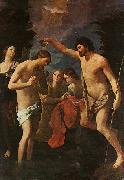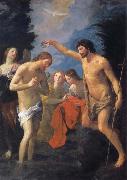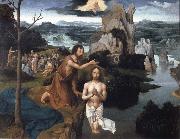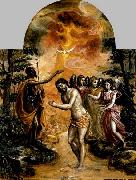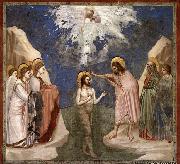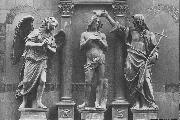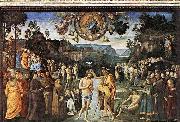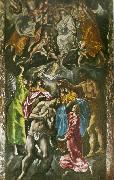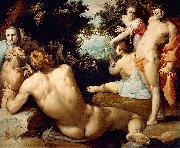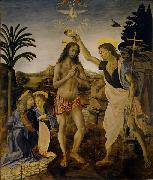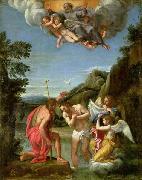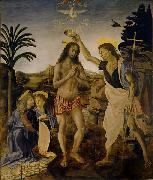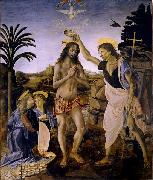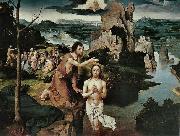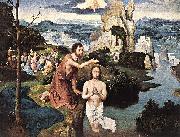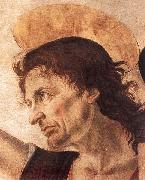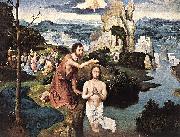Wholesale Oil Painting No Minimum |
|||||||||||
|
|
|||||||||||

|
|||||||||||
|
|
|
||||||||
Guido Reni1575-1642 Italian Guido Reni Galleries Born in Bologna into a family of musicians, Guido Reni was the son of Daniele Reni and Ginevra de?? Pozzi. As a child of nine, he was apprenticed under the Bolognese studio of Denis Calvaert. Soon after, he was joined in that studio by Albani and Domenichino. He may also have trained with a painter by the name of Ferrantini. When Reni was about twenty years old, the three Calvaert pupils migrated to the rising rival studio, named Accademia degli Incamminati (Academy of the "newly embarked", or progressives), led by Lodovico Carracci. They went on to form the nucleus of a prolific and successful school of Bolognese painters who followed Annibale Carracci to Rome. Like many other Bolognese painters, Reni's painting was thematic and eclectic in style. By late 1601, Reni and Albani had moved to Rome to work with the teams led by Annibale Carracci in fresco decoration of the Farnese Palace. During 1601-1604, his main patron was cardinal Sfondrato. By 1604-1605, he received an independent commission for an altarpiece of the Crucifixion of St. Peter. After a few year sojourn in Bologna, he returned to Rome to become one of the premier painters during the papacy of Paul V (Borghese). From 1607-1614, he was one of the painters patronized by Borghese. Abduction of Deianira, 1620-1621.Reni's frescoed ceiling of the large central hall of garden palace, Casino dell'Aurora located in the grounds of the Palazzo Pallavicini-Rospigliosi, is considered his masterpiece. The casino was originally a pavilion commissioned by Cardinal Scipione Borghese; the rear portion overlooks the Piazza Montecavallo and Palazzo del Quirinale. The massive fresco is framed in quadri riportati and depicts Apollo in his Chariot preceded by Dawn (Aurora) bringing light to the world. The work is restrained in classicism, copying poses from Roman Sarcophagi, and showing far more simplicity and restraint than Carracci's riotous Triumph of Bacchus and Ariadne[5] in the Farnese. Reni in this painting is allies himself more with the sterner Cavaliere d'Arpino,Lanfranco, and Albani "School" of mytho-historic painting, and less with the more crowded frescoes characteristic of Pietro da Cortona. There is little concession to perspective, and the vibrantly colored style is antithetical to the tenebrism of Caravaggio's followers. Payments showed that he was paid in 247 scudi and 54 baiocchi upon completion on 24 September 1616. He also frescoed in Paoline Chapel of Santa Maria Maggiore in Rome as well as the Aldobrandini wings of the Vatican. According to rumor, the pontifical chapel of Montecavallo (Chapel of the Annuciation) was assigned to Reni to paint. However, because he felt underpaid by the ministers, the artist left for Bologna, leaving the role of the preeminent artist in Rome to Domenichino. |
||||||||
|
|
||||||||
Baptism of Christ
Baptism of Christ Painting ID:: 3412 |
1623
Art History Museum, Vienna 1623 Art History Museum, Vienna |
|||||||
|
|
||||||||
Guido Reni1575-1642 Italian Guido Reni Galleries Born in Bologna into a family of musicians, Guido Reni was the son of Daniele Reni and Ginevra de?? Pozzi. As a child of nine, he was apprenticed under the Bolognese studio of Denis Calvaert. Soon after, he was joined in that studio by Albani and Domenichino. He may also have trained with a painter by the name of Ferrantini. When Reni was about twenty years old, the three Calvaert pupils migrated to the rising rival studio, named Accademia degli Incamminati (Academy of the "newly embarked", or progressives), led by Lodovico Carracci. They went on to form the nucleus of a prolific and successful school of Bolognese painters who followed Annibale Carracci to Rome. Like many other Bolognese painters, Reni's painting was thematic and eclectic in style. By late 1601, Reni and Albani had moved to Rome to work with the teams led by Annibale Carracci in fresco decoration of the Farnese Palace. During 1601-1604, his main patron was cardinal Sfondrato. By 1604-1605, he received an independent commission for an altarpiece of the Crucifixion of St. Peter. After a few year sojourn in Bologna, he returned to Rome to become one of the premier painters during the papacy of Paul V (Borghese). From 1607-1614, he was one of the painters patronized by Borghese. Abduction of Deianira, 1620-1621.Reni's frescoed ceiling of the large central hall of garden palace, Casino dell'Aurora located in the grounds of the Palazzo Pallavicini-Rospigliosi, is considered his masterpiece. The casino was originally a pavilion commissioned by Cardinal Scipione Borghese; the rear portion overlooks the Piazza Montecavallo and Palazzo del Quirinale. The massive fresco is framed in quadri riportati and depicts Apollo in his Chariot preceded by Dawn (Aurora) bringing light to the world. The work is restrained in classicism, copying poses from Roman Sarcophagi, and showing far more simplicity and restraint than Carracci's riotous Triumph of Bacchus and Ariadne[5] in the Farnese. Reni in this painting is allies himself more with the sterner Cavaliere d'Arpino,Lanfranco, and Albani "School" of mytho-historic painting, and less with the more crowded frescoes characteristic of Pietro da Cortona. There is little concession to perspective, and the vibrantly colored style is antithetical to the tenebrism of Caravaggio's followers. Payments showed that he was paid in 247 scudi and 54 baiocchi upon completion on 24 September 1616. He also frescoed in Paoline Chapel of Santa Maria Maggiore in Rome as well as the Aldobrandini wings of the Vatican. According to rumor, the pontifical chapel of Montecavallo (Chapel of the Annuciation) was assigned to Reni to paint. However, because he felt underpaid by the ministers, the artist left for Bologna, leaving the role of the preeminent artist in Rome to Domenichino. |
||||||||
|
|
||||||||
|
|
Baptism of Christ
Baptism of Christ Painting ID:: 39619 |
mk150
before 1623
Canvas
263.5x186.5cm
mk150 before 1623 Canvas 263.5x186.5cm |
||||||
|
|
||||||||
PATENIER, JoachimFlemish painter (b. ca. 1480, Bouvignes, d. 1524, Antwerpen). |
||||||||
|
|
||||||||
|
|
Baptism of Christ
Baptism of Christ Painting ID:: 39644 |
mk150
c.1515
Signed Oak
59.7x76.3cm
mk150 c.1515 Signed Oak 59.7x76.3cm |
||||||
|
|
||||||||
CIMA da ConeglianoItalian Painter, ca.1459-1517 Italian painter. He belonged to the generation between Giovanni Bellini and Giorgione and was one of the leading painters of early Renaissance Venice. His major works, several of which are signed, are almost all church altarpieces, usually depicting the Virgin and Child enthroned with saints; he also produced a large number of smaller half-length Madonnas. His autograph paintings are executed with great sensitivity and consummate craftsmanship. Fundamental to his artistic formation was the style that Bellini had evolved by the 1470s and 1480s; other important influences were Antonello da Messina and Alvise Vivarini. Although Cima was always capable of modest innovation, his style did not undergo any radical alteration during a career of some 30 years, and his response to the growing taste for Giorgionesque works from the early 16th century remained superficial. He seems to have maintained a sizeable workshop, |
||||||||
|
|
||||||||
|
|
Baptism of Christ
Baptism of Christ Painting ID:: 41204 |
mk157
1493-94
Wood
210x350cm
mk157 1493-94 Wood 210x350cm |
||||||
|
|
||||||||
Piero della FrancescaItalian Early Renaissance Painter, ca.1422-1492 Italian painter and theorist. His work is the embodiment of rational, calm, monumental painting in the Italian Early Renaissance, an age in which art and science were indissolubly linked through the writings of Leon Battista Alberti. Born two generations before Leonardo da Vinci, Piero was similarly interested in the scientific application of the recently discovered rules of perspective to narrative or devotional painting, especially in fresco, of which he was an imaginative master; and although he was less universally creative than Leonardo and worked in an earlier idiom, he was equally keen to experiment with painting technique. Piero was as adept at resolving problems in Euclid, whose modern rediscovery is largely due to him, as he was at creating serene, memorable figures, whose gestures are as telling and spare as those in the frescoes of Giotto or Masaccio. His tactile, gravely convincing figures are also indebted to the sculpture of Donatello, an equally attentive observer of Classical antiquity. In his best works, such as the frescoes in the Bacci Chapel in S Francesco, Arezzo, there is an ideal balance between his serene, classical compositions and the figures that inhabit them, the whole depicted in a distinctive and economical language. In his autograph works Piero was a perfectionist, creating precise, logical and light-filled images (although analysis of their perspective schemes shows that these were always subordinated to narrative effect). However, he often delegated important passages of works (e.g. the Arezzo frescoes) to an ordinary, even incompetent, assistant. |
||||||||
|
|
||||||||
|
|
Baptism of Christ
Baptism of Christ Painting ID:: 48631 |
mk191
Circa 1442
Tempera on the board
167x116cm
mk191 Circa 1442 Tempera on the board 167x116cm |
||||||
|
|
||||||||
Juan Fernandez de NavarreteSpanish painter 1526-1579 was a Spanish Mannerist painter, born at Logroño. An illness in infancy deprived Navarrete of his hearing, but at a very early age he began to express his wants by sketching objects with a piece of charcoal. He received his first instructions in art from Fray Vicente de Santo Domingo, a Hieronymite monk at Estella, and also with Becerra. He visited Naples, Rome, Florence and Milan. Pellegrino Tibaldi met him in Rome in 1550. According to most accounts he was for a considerable time the pupil and assistant of Titian at Venice. In 1568 Philip II of Spain summoned him to Madrid with the title of king's painter and a salary, and employed him to execute pictures for the Escorial. During the 1560s and 1570s the huge monastery-palace of El Escorial was still under construction and Philip II was experiencing difficulties in finding good artists for the many large paintings required to decorate it. Titian was very old, and died in 1576, and Tintoretto, Veronese and Anthonis Mor all refused to come to Spain. Philip had to rely on the lesser talent of Navarrete, whose gravedad y decoro ("seriousness and decorum") the king approved. For eleven years until his death Navarrete worked largely on El Escorial. The most celebrated of the works he produced there are a "Nativity" (in which, as in the well-known work on the same subject by Correggio, the light emanates from the infant Saviour), a "Baptism of Christ" (now Prado), and "Abraham Receiving the Three Angels" (one of his last works, dated 1576). |
||||||||
|
|
||||||||
|
|
Baptism of Christ
Baptism of Christ Painting ID:: 52709 |
c. 1565 Oil on panel, 49 x 37 cm c. 1565 Oil on panel, 49 x 37 cm |
||||||
|
|
||||||||
GRECO, ElGreek-born Spanish Mannerist Painter, 1541-1614 Greek painter, designer and engraver, active in Italy and Spain. One of the most original and interesting painters of 16th-century Europe, he transformed the Byzantine style of his early paintings into another, wholly Western manner. He was active in his native Crete, in Venice and Rome, and, during the second half of his life, in Toledo. He was renowned in his lifetime for his originality and extravagance and provides one of the most curious examples of the oscillations of taste in the evaluation of a painter, |
||||||||
|
|
||||||||
|
|
Baptism of Christ
Baptism of Christ Painting ID:: 62347 |
24 x 18 cm Galleria Estense, Modena The Baptism of Christ is the right panel on the front of the Modena Triptych. The Modena Triptych strikingly illustrates El Greco's transition from post-Byzantine icon painter to European artist of the Latin variety. The portable altarpiece, whose unknown patron perhaps stemmed from a Creto-Venetian family, in its open state shows a total of six scenes: on the front, the central panel bears a rare depiction of the Coronation of the Christian Knight, and on the wings we find the Adoration of the Shepherds on the left and the Baptism of Christ on the right. On the reverse, a View of Mount Sinai with its famous convent of St Catherine is flanked by an Annunciation and an Admonition of Adam and Eve by God the Father. This type of object with its gilded frame elements was common in Cretan workshops of the 16th century, as is its use of wood as a painting support. Author: GRECO, El Title: Baptism of Christ , 1551-1600 , Spanish Form: painting , religious 24 x 18 cm Galleria Estense, Modena The Baptism of Christ is the right panel on the front of the Modena Triptych. The Modena Triptych strikingly illustrates El Greco's transition from post-Byzantine icon painter to European artist of the Latin variety. The portable altarpiece, whose unknown patron perhaps stemmed from a Creto-Venetian family, in its open state shows a total of six scenes: on the front, the central panel bears a rare depiction of the Coronation of the Christian Knight, and on the wings we find the Adoration of the Shepherds on the left and the Baptism of Christ on the right. On the reverse, a View of Mount Sinai with its famous convent of St Catherine is flanked by an Annunciation and an Admonition of Adam and Eve by God the Father. This type of object with its gilded frame elements was common in Cretan workshops of the 16th century, as is its use of wood as a painting support. Author: GRECO, El Title: Baptism of Christ , 1551-1600 , Spanish Form: painting , religious |
||||||
|
|
||||||||
GIOTTO di BondoneItalian Early Renaissance Painter, 1267-1337 Italian painter and designer. In his own time and place he had an unrivalled reputation as the best painter and as an innovator, superior to all his predecessors, and he became the first post-Classical artist whose fame extended beyond his lifetime and native city. This was partly the consequence of the rich literary culture of two of the cities where he worked, Padua and Florence. Writing on art in Florence was pioneered by gifted authors and, although not quite art criticism, it involved the comparison of local artists in terms of quality. The most famous single appreciation is found in Dante's verses (Purgatory x) of 1315 or earlier. Exemplifying the transience of fame, first with poets and manuscript illuminators, Dante then remarked that the fame of Cimabue, who had supposed himself to be the leader in painting, had now been displaced by Giotto. Ironically, this text was one factor that forestalled the similar eclipse of Giotto's fame, which was clearly implied by the poet. |
||||||||
|
|
||||||||
|
|
Baptism of Christ
Baptism of Christ Painting ID:: 62987 |
1304-06 Fresco, 200 x 185 cm Cappella Scrovegni (Arena Chapel), Padua In spite of the high quality details of this scene, the irrational representation of the water in which Christ stands indicates that Giotto was still influenced by medieval iconographic conventions. Artist: GIOTTO di Bondone Painting Title: No. 23 Scenes from the Life of Christ: 7. Baptism of Christ , 1301-1350 Painting Style: Italian , , religious 1304-06 Fresco, 200 x 185 cm Cappella Scrovegni (Arena Chapel), Padua In spite of the high quality details of this scene, the irrational representation of the water in which Christ stands indicates that Giotto was still influenced by medieval iconographic conventions. Artist: GIOTTO di Bondone Painting Title: No. 23 Scenes from the Life of Christ: 7. Baptism of Christ , 1301-1350 Painting Style: Italian , , religious |
||||||
|
|
||||||||
GHIRLANDAIO, DomenicoItalian Early Renaissance Painter, 1449-1494 Florentine painter, whose family name was Bigordi. He may have studied painting and mosaics under Alesso Baldovinetti. Ghirlandaio was an excellent technician. Keenly observant of the contemporary scene, he depicted many prominent Florentine personalities within his religious narrative paintings. Among his earliest frescoes are the Madonna with the Vespucci Family and the Last Supper (Church of the Ognissanti, Florence). He painted scenes from the life of Santa Fina (collegiate church in San Gimigniano) and frescoes in the Palazzo Vecchio, Florence. In 1481, Pope Sixtus IV called him to Rome, along with Botticelli, to decorate the Sistine Chapel. He painted the Calling of the First Apostles, a scene close in spirit to Masaccio. He returned to Florence to work on the frescoes in the Sassetti Chapel in Santa Trinita. He introduced Sassetti, Corsi, Poliziano, the Medici, and many other contemporaries as participants in the life of St. Francis. Ghirlandaio's most famous achievement is his fresco cycle of the life of Mary and St. John the Baptist for the choir of Santa Maria Novella. Michelangelo served an apprenticeship with him at this time and probably worked on these frescoes. Other examples of his art are the Adoration of the Magi (Uffizi); another Adoration (Hospital of the Innocents); a mosaic of the Annunciation for the Cathedral; a portrait of Francesco Sassetti and his son (Metropolitan Mus.); |
||||||||
|
|
||||||||
|
|
Baptism of Christ
Baptism of Christ Painting ID:: 63006 |
1473 Fresco Sant'Andrea a Brozzi, San Donnino The fresco is in the tympanum above the Madonna and Child with Saints. Two angels are kneeling on the left bank of the river Jordan, shown as a little flat stream flowing towards us. They are holding the clothes of the person being baptized, who is clad only in a loincloth. Christ is standing in water up to his ankles. St John the Baptist, in a fur robe, is gathering up his cloak and stepping carefully on to a stone to baptize Christ. This fresco, because of its poorer quality, is frequently attributed to assistants from Ghirlandaio's workshop. It is a loose copy of the famous panel painting which Verrocchio painted with the help of his assistant Leonardo da Vinci. Ghirlandaio added the two praying angels on the right of his composition, and these, together with the corresponding figures on the other side of the river, form a compositional frame for the work.. This assumption that clear symmetrical balance is important shows that the artist was still rather conservative. Artist: GHIRLANDAIO, Domenico Painting Title: Baptism of Christ , 1451-1500 Painting Style: Italian , , religious 1473 Fresco Sant'Andrea a Brozzi, San Donnino The fresco is in the tympanum above the Madonna and Child with Saints. Two angels are kneeling on the left bank of the river Jordan, shown as a little flat stream flowing towards us. They are holding the clothes of the person being baptized, who is clad only in a loincloth. Christ is standing in water up to his ankles. St John the Baptist, in a fur robe, is gathering up his cloak and stepping carefully on to a stone to baptize Christ. This fresco, because of its poorer quality, is frequently attributed to assistants from Ghirlandaio's workshop. It is a loose copy of the famous panel painting which Verrocchio painted with the help of his assistant Leonardo da Vinci. Ghirlandaio added the two praying angels on the right of his composition, and these, together with the corresponding figures on the other side of the river, form a compositional frame for the work.. This assumption that clear symmetrical balance is important shows that the artist was still rather conservative. Artist: GHIRLANDAIO, Domenico Painting Title: Baptism of Christ , 1451-1500 Painting Style: Italian , , religious |
||||||
|
|
||||||||
|
|
||||||||
|
|
Baptism of Christ
Baptism of Christ Painting ID:: 63092 |
1502-05 Marble, 282 and 260 cm with bases Baptistry, Florence This group is located over the east entrance of the Baptistry. Artist: SANSOVINO, Andrea Painting Title: Baptism of Christ , 1501-1550 Painting Style: Italian , sculpture Type: religious 1502-05 Marble, 282 and 260 cm with bases Baptistry, Florence This group is located over the east entrance of the Baptistry. Artist: SANSOVINO, Andrea Painting Title: Baptism of Christ , 1501-1550 Painting Style: Italian , sculpture Type: religious |
||||||
|
|
||||||||
PERUGINO, PietroItalian painter, Umbrian school (b. 1450, Citta della Pieve, d. 1523, Perugia). Italian painter and draughtsman. He was active in Perugia, Florence and Rome in the late 15th century and early 16th. Although he is now known mainly as the teacher of Raphael, he made a significant contribution to the development of painting from the style of the Early Renaissance to the High Renaissance. The compositional model he introduced, combining the Florentine figural style with an Umbrian use of structure and space, |
||||||||
|
|
||||||||
|
|
Baptism of Christ
Baptism of Christ Painting ID:: 63529 |
1482 Fresco, 335 x 540 cm Cappella Sistina, Vatican The fresco is from the cycle of the life of Christ in the Sistine Chapel. It was painted by Perugino and Pinturicchio, the latter being probably responsible for the landscape and minor scenes. The paintings were to be read in pairs, one from the left and one from the right. Thus the Baptism of Christ faces the Circumcision of Moses' son by Perugino and Pinturicchio. A comparison of the pairs of scenes shows clearly that the principal concern was to show how the new religion of Christ was deeper and more spiritual than the Jewish religion. Thus the pair of frescoes showing the Baptism and the Circumcision emphasize how baptism - prefigured, according to Augustine and many of the Fathers of Church, by circumcision - represents a "spiritual circumcision."Artist:PERUGINO, Pietro Title: Baptism of Christ Painted in 1451-1500 , Italian - - painting : religious 1482 Fresco, 335 x 540 cm Cappella Sistina, Vatican The fresco is from the cycle of the life of Christ in the Sistine Chapel. It was painted by Perugino and Pinturicchio, the latter being probably responsible for the landscape and minor scenes. The paintings were to be read in pairs, one from the left and one from the right. Thus the Baptism of Christ faces the Circumcision of Moses' son by Perugino and Pinturicchio. A comparison of the pairs of scenes shows clearly that the principal concern was to show how the new religion of Christ was deeper and more spiritual than the Jewish religion. Thus the pair of frescoes showing the Baptism and the Circumcision emphasize how baptism - prefigured, according to Augustine and many of the Fathers of Church, by circumcision - represents a "spiritual circumcision."Artist:PERUGINO, Pietro Title: Baptism of Christ Painted in 1451-1500 , Italian - - painting : religious |
||||||
|
|
||||||||
El GrecoGreek-born Spanish Mannerist Painter, 1541-1614 Considered a representative of late Renaissance Spanish art, El Greco was actually born in Greece, on the island of Crete. After studying in Venice under Titian, El Greco settled in Toledo, Spain in 1577. At the time he was wildly popular, his emotionally religious paintings being just the ticket for the hometown of the Spanish Inquisition. After his death his work was largely ignored until the beginning of the 20th century; now he considered one of the inspired geniuses of Western art. His distinctive style features bold shapes and colors, with elongated and slightly distorted figures. In Toledo El Greco was in constant demand and liked living large: he maintained a private orchestra to accompany his meals. |
||||||||
|
|
||||||||
|
|
baptism of christ
baptism of christ Painting ID:: 64083 |
painted c. 1609-14,cossio
162x76
hospital of san juan bautista, toledo painted c. 1609-14,cossio 162x76 hospital of san juan bautista, toledo |
||||||
|
|
||||||||
Paolo Veronese1528-1588 Paolo Veronese Galleries Italian painter and draughtsman. With Titian and Tintoretto he makes up the triumvirate of great painters of the late Renaissance in Venice. He is known as a supreme colourist and for his illusionistic decorations in both fresco and oil. His large paintings of biblical feasts executed for the refectories of monasteries in Venice and Verona are especially celebrated. He also produced many altarpieces, history and mythological paintings and portraits. His compositional sketches in pen, ink and wash, figure studies in chalk, and chiaroscuro modelli and ricordi form a significant body of drawings. He headed a family workshop that remained active after his death. |
||||||||
|
|
||||||||
|
|
baptism of christ
baptism of christ Painting ID:: 69063 |
milan, brera. 248x450cm
se milan, brera. 248x450cm se |
||||||
|
|
||||||||
CORNELIS VAN HAARLEMDutch painter (b. 1562, Haarlem, d. 1638, Dutch painter and draughtsman, was one of the leading Northern Mannerist artists in The Netherlands, and an important forerunner of Frans Hals as a portraitist. Cornelis Corneliszoon was a member of the Mannerist school of Haarlem, which was highly influenced by the work of Bartholomeus Spranger, whose drawings were brought to Haarlem by Carel van Mander in 1585, and had a strong immediate effect.[1] He painted mainly portraits as well as mythological and Biblical subjects. Initially Corneliszoon painted large-size, highly stylized works with Italianate nudes in twisted poses with a grotesque, unnatural anatomy. Later, his style changed to one based on the Netherlandish realist tradition. When his parents fled Haarlem in 1572, as the Spanish army laid siege to the city during the Eighty Years' War, Corneliszoon remained behind and was raised by the painter Pieter Pietersz., his first teacher. Later, Corneliszoon studied in Rouen, France and Antwerp, Belgium. Corneliszoon in 1583 received his first official commission from the city of Haarlem, a militia company portrait, the Banquet of the Haarlem Civic Guard. He later became city painter of Haarlem and received numerous official commissions. As a portrait painter, both of groups and individuals, he was an important influence on Frans Hals. Together with Carel van Mander, Hendrick Goltzius and other artists, Corneliszoon formed the Haarlem Academy or "Haarlem Mannerists". Probably this was a very informal grouping, perhaps meeting to draw nude models, and certainly to exchange artistic views.[2] Corneliszoon also played a role in reorganizing the Haarlem artists' and artisans' Guild of St. Luke, eliminating its medieval organization and raising the status of the artists. Corneliszoon married Maritgen Arentsdr Deyman, the daughter of a mayor of Haarlem, sometime before 1603. |
||||||||
|
|
||||||||
|
|
baptism of Christ
baptism of Christ Painting ID:: 70870 |
Medium Oil on canvas
Dimensions 170.5 x 206 cm
Medium Oil on canvas Dimensions 170.5 x 206 cm |
||||||
|
|
||||||||
Andrea del VerrocchioItalian Early Renaissance Sculptor, ca.1435-1488 Florentine sculptor and painter, whose real name was Andrea di Michele di Francesco di Cioni. He was a leading figure in the early Renaissance, and his workshop was a center for the training of young artists in Florence. A virtuoso metalworker, Verrocchio was primarily concerned with the spirited rendering of movement and the elaboration of detail. Many of his paintings are lost. Of the remaining panels, his hand is evident in the Baptism of Christ (Uffizi), assisted by Leonardo da Vinci. In the Pistoia altarpiece he was aided by Lorenzo di Credi. Other attributions are Tobias and the Angel (National Gall., London), two paintings of the Madonna and Child (National Gall., London; Berlin), and a Crucifixion with Saints (Argiano). Most of Verrocchio's achievements in sculpture have survived. His earlier work includes the bold group Incredulity of St. Thomas (Orsanmichele). In 1472 he designed the tombs of Piero and Giovanni de' Medici (San Lorenzo). In the same period he created the graceful Boy with a Dolphin and a lithe portrayal of David (Bargello). He went to Venice (c.1480) to work on the equestrian monument of the condottiere Bartolomeo Colleoni. |
||||||||
|
|
||||||||
|
|
Baptism of Christ
Baptism of Christ Painting ID:: 72288 |
from 1470(1470) until 1475(1475)
Oil and tempera on panel
cjr from 1470(1470) until 1475(1475) Oil and tempera on panel cjr |
||||||
|
|
||||||||
Francesco Albani(March 17 or August 17, 1578 COctober 4, 1660) was an Italian Baroque painter. Born at Bologna, his father was a silk merchant who intended to instruct his son in the same trade; but by age twelve, Albani became an apprentice under the competent mannerist painter Denis Calvaert, where he met Guido Reni. Soon he followed Reni to the so-called "Academy" run by the Carracci family: Annibale, Agostino, and Ludovico. This studio fostered the careers of many painters of the Bolognese school, including Domenichino, Massari, Viola, Lanfranco, Giovanni Francesco Grimaldi, Pietro Faccini, Remigio Cantagallina, and Reni. In the year 1600, Albani moved to Rome to work in the fresco decoration of the gallery of the Palazzo Farnese, being completed by the studio of Annibale Carracci. Rome, under Clement VIII Aldobrandini (1592-1605) was exhibiting some degree of administrative stability and renewed artistic patronage. While pope Clement was born from a Florentine family residing in Urbino, his family was allied by marriage to the Emilia-Romagna and the Farnese, since Ranuccio I Farnese, Duke of Parma had married Margherita Aldobrandini. Parma, like Bologna, are part of the Region of Emilia-Romagna. Thus it was not surprise that Cardinal Odoarde Farnese, Ranuccio's brother, chose the Carraccis from Bologna for patronage, thereby establishing Bolognese predominance of Roman fresco painting for nearly two decades. |
||||||||
|
|
||||||||
|
|
Baptism of Christ
Baptism of Christ Painting ID:: 73796 |
Baptism of Christ
cjr Baptism of Christ cjr |
||||||
|
|
||||||||
Andrea del VerrocchioItalian Early Renaissance Sculptor, ca.1435-1488 Florentine sculptor and painter, whose real name was Andrea di Michele di Francesco di Cioni. He was a leading figure in the early Renaissance, and his workshop was a center for the training of young artists in Florence. A virtuoso metalworker, Verrocchio was primarily concerned with the spirited rendering of movement and the elaboration of detail. Many of his paintings are lost. Of the remaining panels, his hand is evident in the Baptism of Christ (Uffizi), assisted by Leonardo da Vinci. In the Pistoia altarpiece he was aided by Lorenzo di Credi. Other attributions are Tobias and the Angel (National Gall., London), two paintings of the Madonna and Child (National Gall., London; Berlin), and a Crucifixion with Saints (Argiano). Most of Verrocchio's achievements in sculpture have survived. His earlier work includes the bold group Incredulity of St. Thomas (Orsanmichele). In 1472 he designed the tombs of Piero and Giovanni de' Medici (San Lorenzo). In the same period he created the graceful Boy with a Dolphin and a lithe portrayal of David (Bargello). He went to Venice (c.1480) to work on the equestrian monument of the condottiere Bartolomeo Colleoni. |
||||||||
|
|
||||||||
|
|
Baptism of Christ
Baptism of Christ Painting ID:: 73914 |
Date from 1470(1470) until 1475(1475)
Medium Oil and tempera on panel
Dimensions Width: 152 cm (59.84 in). Height: 180 cm (70.87 in).
cyf Date from 1470(1470) until 1475(1475) Medium Oil and tempera on panel Dimensions Width: 152 cm (59.84 in). Height: 180 cm (70.87 in). cyf |
||||||
|
|
||||||||
Andrea del VerrocchioItalian Early Renaissance Sculptor, ca.1435-1488 Florentine sculptor and painter, whose real name was Andrea di Michele di Francesco di Cioni. He was a leading figure in the early Renaissance, and his workshop was a center for the training of young artists in Florence. A virtuoso metalworker, Verrocchio was primarily concerned with the spirited rendering of movement and the elaboration of detail. Many of his paintings are lost. Of the remaining panels, his hand is evident in the Baptism of Christ (Uffizi), assisted by Leonardo da Vinci. In the Pistoia altarpiece he was aided by Lorenzo di Credi. Other attributions are Tobias and the Angel (National Gall., London), two paintings of the Madonna and Child (National Gall., London; Berlin), and a Crucifixion with Saints (Argiano). Most of Verrocchio's achievements in sculpture have survived. His earlier work includes the bold group Incredulity of St. Thomas (Orsanmichele). In 1472 he designed the tombs of Piero and Giovanni de' Medici (San Lorenzo). In the same period he created the graceful Boy with a Dolphin and a lithe portrayal of David (Bargello). He went to Venice (c.1480) to work on the equestrian monument of the condottiere Bartolomeo Colleoni. |
||||||||
|
|
||||||||
|
|
Baptism of Christ
Baptism of Christ Painting ID:: 75117 |
Date ca. 1475(1475)
Medium Oil on panel
Dimensions 177 X 151 cm (69.68 X 59.45 in)
cyf Date ca. 1475(1475) Medium Oil on panel Dimensions 177 X 151 cm (69.68 X 59.45 in) cyf |
||||||
|
|
||||||||
Joachim PatinirFlemish Northern Renaissance Painter, ca.1485-1524 |
||||||||
|
|
||||||||
|
|
Baptism of Christ
Baptism of Christ Painting ID:: 83478 |
1510-1515
Medium English: Oil on wood
Dimensions 59.7 x 76.3 cm (23.5 x 30 in)
cjr 1510-1515 Medium English: Oil on wood Dimensions 59.7 x 76.3 cm (23.5 x 30 in) cjr |
||||||
|
|
||||||||
Joachim PatinirFlemish Northern Renaissance Painter, ca.1485-1524 |
||||||||
|
|
||||||||
|
|
Baptism of Christ
Baptism of Christ Painting ID:: 84554 |
Date first half of 16th century
Medium Oil on oak
Dimensions Height: 59.5 cm (23.4 in). Width: 77 cm (30.3 in).
cjr Date first half of 16th century Medium Oil on oak Dimensions Height: 59.5 cm (23.4 in). Width: 77 cm (30.3 in). cjr |
||||||
|
|
||||||||
Andrea del VerrocchioItalian Early Renaissance Sculptor, ca.1435-1488 Florentine sculptor and painter, whose real name was Andrea di Michele di Francesco di Cioni. He was a leading figure in the early Renaissance, and his workshop was a center for the training of young artists in Florence. A virtuoso metalworker, Verrocchio was primarily concerned with the spirited rendering of movement and the elaboration of detail. Many of his paintings are lost. Of the remaining panels, his hand is evident in the Baptism of Christ (Uffizi), assisted by Leonardo da Vinci. In the Pistoia altarpiece he was aided by Lorenzo di Credi. Other attributions are Tobias and the Angel (National Gall., London), two paintings of the Madonna and Child (National Gall., London; Berlin), and a Crucifixion with Saints (Argiano). Most of Verrocchio's achievements in sculpture have survived. His earlier work includes the bold group Incredulity of St. Thomas (Orsanmichele). In 1472 he designed the tombs of Piero and Giovanni de' Medici (San Lorenzo). In the same period he created the graceful Boy with a Dolphin and a lithe portrayal of David (Bargello). He went to Venice (c.1480) to work on the equestrian monument of the condottiere Bartolomeo Colleoni. |
||||||||
|
|
||||||||
|
|
Baptism of Christ
Baptism of Christ Painting ID:: 85523 |
VERROCCHIO, Andrea del The Baptism of Christ
Oil on wood, 177 x 151 cm
cyf VERROCCHIO, Andrea del The Baptism of Christ Oil on wood, 177 x 151 cm cyf |
||||||
|
|
||||||||
Joachim PatinirFlemish Northern Renaissance Painter, ca.1485-1524 |
||||||||
|
|
||||||||
|
|
Baptism of Christ
Baptism of Christ Painting ID:: 88403 |
first half of 16th century
Medium Oil on oak
cyf first half of 16th century Medium Oil on oak cyf |
||||||
|
|
||||||||
|
Joachim Patinir Flemish Northern Renaissance Painter, ca.1485-1524 Baptism of Christ first half of 16th century Medium Oil on oak cyf |
||||||||
|
|
||||||||
|
Prev Next
|
||||||||
|
|
||||||||
|
Related Paintings to Joachim Patinir :. |
||||||||
|
|
||||||||
|
CONTACT US |
